Todwick Environment: Wild Birds
SK58 Birders – November 2021
I’m sure many Todwick residents have seen large flocks of birds overhead, flying in a V formation and being quite vocal. These are Pink-footed Geese.
These Geese have breeding grounds in Iceland, Greenland and of course in the arctic regions of Northern Europe. This time of year, especially October / November they are on the move to find food. The coastal areas around the Solway Firth and in Norfolk are their main wintering sites. The Iceland birds favouring Scotland and the European ones heading to the Norfolk fields, especially where the sugar beet crops have been harvested, the farmers leaving the discarded vegetation as feed. The Geese also appear to commute between these sites and Todwick is very much on their flight path. Identification is really straightforward as no other Goose species behaves like them. Pink feet are obviously not identifiable with the birds high in the sky, but their overall size, shortish neck and the typical aerodynamic V shaped flight pattern is a sure clincher.
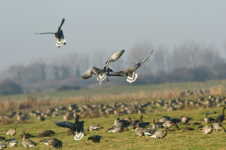
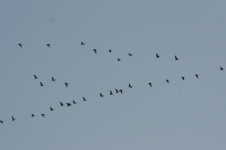
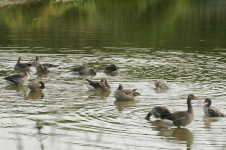
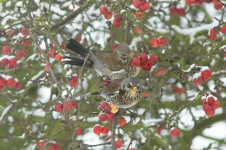
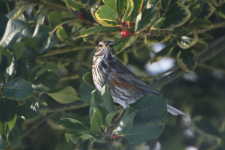
The other Goose species which is very common just now is the Greylag Goose. These are the wild variety of the farmyard Goose, their numbers are on the increase with flocks at Langold Lake, occasionally on Tommy Flockton’s Marsh and at Rother Valley CP, sometimes as many as 30 birds. They are noisy birds, have a heavy orangish bill and much grey in the wings, visible in flight.
Canada Geese are also common at most water sites, their black / white plumage being unmistakable. A rather ubiquitous species and not popular with everyone.
Just a note to mention that the Winter Thrushes are arriving. Flocks of Redwing have been recorded overhead, very vocal when flying overhead at night. The larger Fieldfare arrive a little later but are now present in quite large numbers. Fieldfare are very vocal, uttering a schack-schack sort of call, easy to recognize once heard a few times. Both species are attracted to berry trees, especially hawthorn, and will feed in large numbers on farmland.
Enjoy the outdoors and keep an eye on the sky for those Pink-footed Geese.
Brian Chambers
SK58 Birders – September 2021
September 2021 sees a return to our normal programme. The monthly meetings will resume on the last Wednesday of the month at The Loyal Trooper Inn, South Anston. Starting at 7.30 pm, new faces are always most welcome. Do not be intimidated, detailed birding knowledge is not needed just an interest and love of bird life and Natural History.
- 29 September 2021 – A talk plus slides “Dragonflies & Butterflies”
- 27 October 2021 – “The Fabulous Falklands”
- 24 November 2021 – “New Guinea”
During the Autumn months, large bird flocks can be seen feeding on our local fields. The most obvious are the Gulls, hundreds can descend as the fields are ploughed mainly picking up earthworms. The most numerous large Gulls are the Lesser black-backed, the mature adults as the name says have black back feathers, white heads & chests and yellow legs. Immature birds are darker overall with lighter coloured legs.
Similar gulls but smaller are the Black-headed, somewhat of a confusing name as they lose the black head after breeding, just a black smudge remaining behind the eye. Identification can be helped by their red legs and inner bill, a very white leading edge to the wing is quite obvious in flight.
Rooks, Jackdaws and Crows can also be present in big numbers, the adults joined by the youngsters. These birds tend to be more often on the new stubble fields which seem to hold an endless supply of beetles. It can be tricky separating species. Jackdaws are the smallest and have grey heads. Rooks have a pale bill compared to the black bill of the Crows, they are also the more numerous. Generally large flocks of Starling are also feeding amongst them.
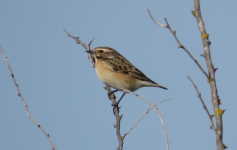
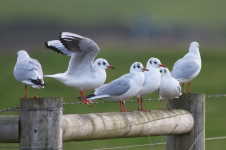
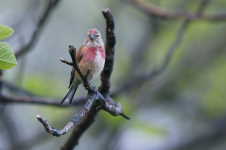
Two finch species also form big flocks at this time of the year. Linnets in flocks of 100+ are common on the fields towards South Anston, again usually in the stubble where the spilt seed is the attraction. Then there are flocks of Goldfinch, large but usually a bit smaller than Linnet flocks, they love to feed on patches of thistles.
There have been two recent sightings of migrant birds on the stone wall beside the footpath to South Anston. Now is the time of year that the summer visitors are starting to migrate back south. Two Wheatears and a Whinchat were recorded at the beginning of the month. Both are colourful birds, the Whinchat smaller of the two has a white eye stripe, the Wheatear has the obvious white rump very visible in flight. If you take a regular walk across towards South Anston then seeing one of the above species is very possible.
Enjoy your Autumn birds, the residents plus the migrants passing through. Todwick with its many surrounding fields plus a few hedges is still a place attractive to many bird species.
SK58 Birders – July 2021
The Covid restrictions are much reduced now, so SK58 Birders Group can return to almost normal operation. The monthly meetings are due to start again in September also the monthly walks at Langold Lake. Details can be found on the Group’s web site. There has been heightened interest throughout the country in all sorts of Natural History during the lockdowns, so if you wish to extend your bird watching then SK58 Birders Group will be very pleased to meet you on the walks or at the meetings.
Now is a good time of the year to see or hear Owls. The Group have placed many Barn Owl nesting boxes around our area, locally at Anston Stones Wood, Brampton Common and Kiveton. The birds will now be feeding hungry broods of up to 4 young, a tough job to find sufficient voles, frogs etc. Thus, they are often out hunting at dawn and dusk, good sites to see them are our rewilded pit sites at Dinnington and Kiveton.
Similarly, the Tawny Owl, but this species is much more nocturnal, hearing the young birds calling for food is much more likely than actually getting a sighting.
Long-eared owls are a lesser-known Owl species but are not uncommon, their body is a little smaller than a Tawny’s but the wings are longer and narrower. These are also crepuscular, hunt dawn and dusk. Good sites to see them of an evening is over the old Thurcroft pit site and nearer to home the Kiveton pit site is an excellent hunting spot.
Our fourth Owl species is the Little Owl, these birds do spend a lot of time out during daytime. They do breed around Todwick and can be seen around the old sewage works site, on the paths towards South Anston and of course at Kiveton pit site. They have also been seen in Todwick gardens so you may be lucky.
Another very active site, reasonably local, is near Hodsock. Take the track off the A60, opposite the entrance to Langold Lake. After about a mile you will see a large pond on the right. This has attracted a number of wader species lately. Birds passing through include Redshank, Ringed Plover and Little Ringed Plover, resident birds include Oystercatcher and many Lapwing. A good site for the above plus lots of other species attracted to the varied habitat.
A few thoughts on how to see a few more uncommon species, good luck with your bird watching.
Brian Chambers
SK58 Birders – May 2021
April and now May 2021 have been cold months, although the skies have been clear and blue a lot of the time, there has been frost and a chill wind. This combination has delayed both bird migration and early nesting.
The Swallows, House Martins and Sand Martins are around but not in great numbers, their aerial insect prey must be difficult to find in sufficient quantity, so feeding young is hard work.
Wheatear have been recorded on the fields across to South Anston, usually fairly close to the old stone wall. This wall forms an excellent perch for the birds plus a good spot for the birdwatcher to see the birds before they disappear into the crops.
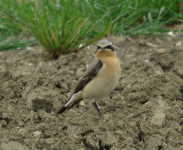
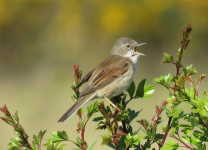
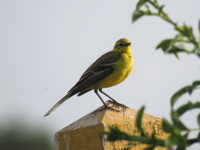
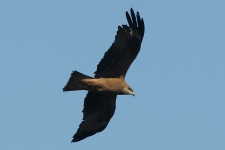
Also seen here are Yellow Wagtails, the male in splendid yellow around the head and chest, the female more camouflaged with subdued colours. Common Whitethroat are also resident by the wall, at least 3 pairs, the white throat being diagnostic plus their constant croaky song usually delivered from a conspicuous perch. The other common bird at this location is the Reed Bunting, the male identified by its black head.
These fields still support many bird species, in addition to those mentioned above there are Skylark, Wren, Dunnock (or Hedge Sparrow), Blackbird, Starling, House Sparrow, Wood Pigeon (too many) and often the raptors Kestrel, Sparrowhawk and Buzzard. This is not a full list as all sorts can turn up from time to time. In contrast, Lapwing no longer nest here, and the Winter Golden Plover flocks are very small nowadays.
One such is the Little Egret, smaller than a Heron and basically all white, this was seen by the flooded field adjacent to the A57 a few weeks ago. Today, May 16th, my wife heard a Cuckoo calling from woodland at the reclaimed Kiveton Colliery site. This is now a rare species in the SK58 square, occasional birds pass through, but it must be at least 10 years since they last bred.
Further afield, east of South Anston, a Black Kite was recorded passing through. This bird is smaller than the Red Kite, a species becoming ever more common in our area. Black Kite records are few in Yorkshire, the birds are common in Southern & Eastern Europe. So, it just demonstrates that unusual, rare species can appear in Todwick just as well as anywhere else.
Springtime for Todwick birds
Published: 28 March 2021
I’m sure there will be many nest boxes around the village gardens, we have a rather ambitious seven in place. There are many different sizes available designed to attract various species, the most common being the tit box.
Ideally the boxes should be placed during the Winter months, but it is still not too late, better late than never. The blue tit box entrance hole is recommended at 25 mm diameter, the great tit’s a little larger at 28 mm and for House Sparrow 32 mm. It is possible to buy a small metal plate with the appropriate size hole, this stops other birds, animals from trying to smash their way in to rob the nest.
Siting is of course important, some cover is ideal but there must be a clear flight path into the box and just as important a clean getaway. Place 4-5 meters high with the box facing away from the prevailing winds and out of the direct glare of the sun. This suggests a NE direction for perfection but anywhere between W and E should be OK.
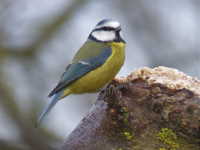
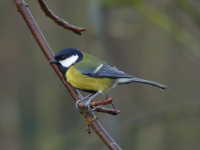
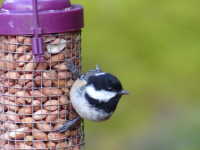
If the box has been in use then a good clean out of old material is essential, if it is in use early then a clean out could encourage a second brood. It is not recommended to place nesting material in the box, let the birds gather their own.
Blue and Great Tits start searching for suitable sites as early as February but don’t actually start breeding until April/May, so now is the time to have your boxes in place, Good Luck.
I would be interested to know just how many birds and which species nest in our Todwick gardens. Which use nest boxes, hedges, bushes, outbuildings etc, please let me know if you have a nest, the site and species if you can.
Please email me any sightings: brianchambers101940@hotmail.com
Thank you,
Brian Chambers
SK58 Birders – February 2021
I should imagine that most of Todwick’s residents have seen a Buzzard flying over the village. Here, at the Kiveton end of The Meadows the bird regularly perches on the fence of the horse’s field. I have posted some photos on the Todwick Facebook page.
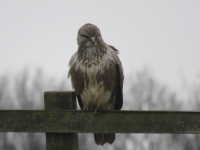
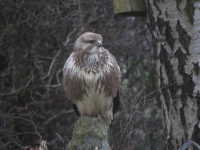
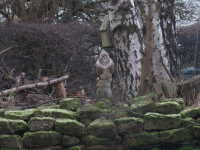
Buzzard numbers suffered greatly in the 50’s & 60’s because of organochlorine pesticide use, raptor persecution and rabbit myxomatosis. Their favoured foods are rabbits (killed by the disease) also beetles and earthworms (killed by the chemicals). Since the 70’s numbers have increased dramatically, now being estimated at about 60 - 70,000 pairs to become the UK’s most common raptor after Kestrel. 25 years ago, the only Buzzards locally were over Kings Wood at Firbeck, now you may see 20+ birds at this site and if you go for a walk anywhere you expect to see one.
They are large birds usually seen gliding, often quite high, and heard with their mewing calls. They hunt over open fields and woodland as we have around Todwick, covering a large area in search of food, now more likely to be carrion, due to decline in the rabbit population. They are not specialised feeders, will eat most things protein, so that helps survival. They will take other birds, even pigeon, rodents such as rats, mice and even small things like earthworms, beetles etc. They really do not have any natural predators except possibly squirrels which will take a few eggs or young, and of course are easily disturbed by human activity.
They form lifetime pairs, display and start nest building March / April, building large nests of twigs and branches of 1 metre+ width in trees or rocky crags, usually lay 2/3 eggs, the birds fledging about July. The bird near our house is very light brown, a juvenile, so will not breed until 3 years old. However, I have seen a pair of adult birds flying together which presumably breed locally.
Raptor birds are not popular with everyone as they do take a good few songbirds, but they are all part of the ecosystem and their prevalence or not is a good indicator of the health of the environment. So, enjoy the sight of our local Buzzards, also the local Kestrels and Sparrowhawks and if you are very fortunate a Red Kite, another raptor seen ever more often in the Todwick area.
Brian Chambers
SK58 Birders – January 2021
The members of SK58 Birders, like all other societies, are not able to meet but are getting around our locality and reporting birds. The recording area, known as our local patch in bird watching terms, is the OS grid reference SK58. The web site, SK58Birders.com, has masses of information on birds seen, a species list of birds recorded over the years, local birding hotspots and much more. Definitely worth checking out if you have an interest in local bird news.
The Winter is a tough time for birds and also for us, so watching garden birds is an attractive option. Especially with snow and frost around, gardens are a source of easy pickings if food is put out. We have found that a mixture of bird seed, sunflower hearts and chopped peanuts together with cheap lard makes a tempting dish. With this we have a regular pair of Great Spotted Woodpecker, flocks of 30+ Chaffinch, about 20 House Sparrow, a maximum count so far of 15 Blackbirds, a good number of Goldfinch and a couple of Yellowhammer. Yellowhammer numbers are disappointing this year as previously a flock of over 30 have visited, it just shows how quickly things can change. We have had a Common Buzzard quite often circling over the adjacent fields which actually perched on the bird table for a while.
The Golden Plover are occasionally present on the fields between Todwick and Anston but not as often as previous years. About 20 were recorded early this year, at one time 2000+ flocks were common. Stonechat have been seen perched on the wall, Grey Heron standing in the fields and it’s not unusual to spot Cormorants flying over.
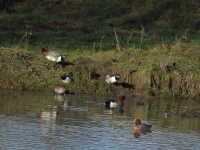
Flockton’s Marsh
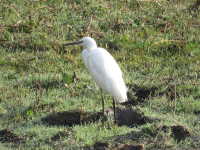
Flockton’s Marsh
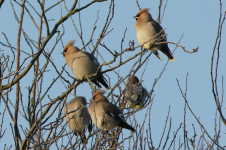
Tommy Flockton’s field, on the line of the canal off Hard Lane, has a good stretch of water. Duck species are attracted here especially over the Winter as migrant species flock in from Northern Europe. Mallard are ever present, maybe 40+, Teal, a small duck species, are also common. The male has the green and brown head markings, the female just brown but both have the glossy green speculum/wingbar, very visible in flight. A Flock of 20+ Wigeon are also regular visitors, forming a tight flock feeding on the grass alongside the water. The white Heron (Little Egret) is becoming a much more common sight as well.
Further afield at Langold Lake a few Goosander have been reported, also Pochard, and a very rare visit from a Goldeneye. This species is often at Rother Valley and other close by water sites but only rarely appears within the SK58 region. Another rare visitor was a Pintail Duck to Carlton Lake last December. We have many keen birders out scanning the area, usually recording common species so a rarity always generates some excitement.
There are plenty of Winter Thrush, Fieldfare and Redwing plus lots of extra Blackbirds from Europe feeding on hedgerow berries and in the stubble fields. One much sort after bird is the Waxwing, often attracted to supermarket carpark’s Rowan berries, or any well laden berry tree. They flocked to a tree at Kiveton a few years ago so keep your eyes open, if you see some let SK58 birders know via the web site, you will be very popular.
Keep up with the bird feed and let me know if you see anything special at brianchambers101940@hotmail.com
Brian Chambers
Continue to 2019 reports.
